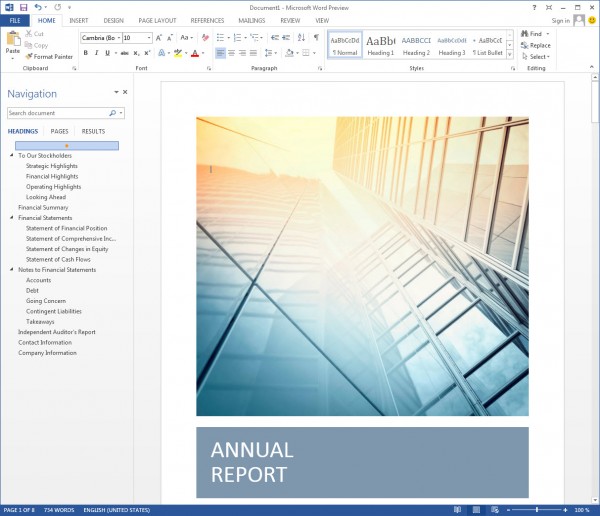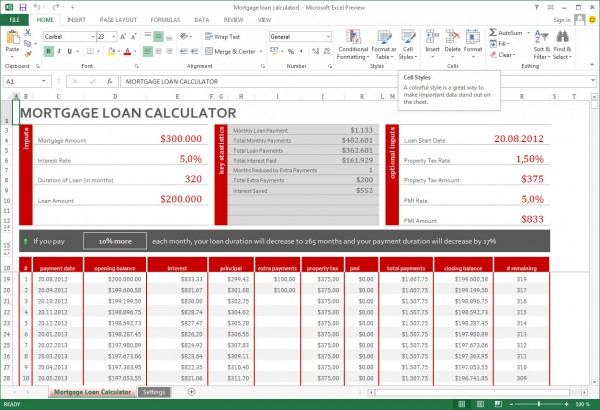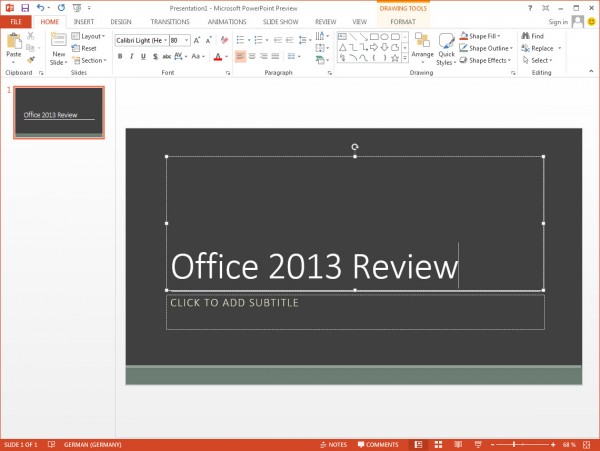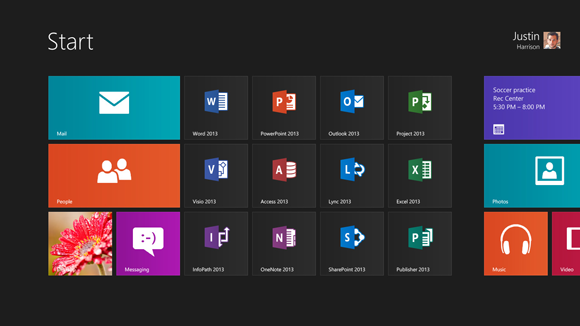A (p)review of Microsoft Office 2013

Microsoft released the preview version of Office 2013 less than a week ago. This new installment of the productivity suite has many of the same features as its previous versions, 2003, 2007, and 2010: Word, Excel, Access, PowerPoint, and Outlook. But there are other programs as well, and Microsoft has connected the Office Suite to the Azure Cloud.
In this review I’ll discuss the requirements for installation and the installation process. I’ll also discuss the contents of three of the Office 2013 suite programs, Word, Excel and PowerPoint, and how the cloud-based Office 365 may change the way many users work with the suite. I’ll also talk about Windows 8 integration, and wrap up with a discussion about the impact that Office 2013 can have in business enterprises.
For Starters: The Requirements
Okay, let’s talk about the requirements for Office 2013. It will run on Windows 7 and Windows 8, on desktop PCs, notebooks, tablets, and mobile phones, or on Windows Server 2008 R2 or later. The Office 2013 family includes a large number of desktop apps as well as server products like Exchange and SharePoint. Office 2013 will not run on Windows XP or Vista; this means that more than half of all computers currently running Windows will need an upgrade first.
| Component | Office 2013 Preview Requirements |
|---|---|
| Computer and processor | 1 gigahertz (Ghz) or faster x86- or x64-bit processor with SSE2 instruction set |
| Memory (RAM) | 1 gigabyte (GB) RAM (32 bit); 2 gigabytes (GB) RAM (64 bit) |
| Hard Disk | 3.0 gigabytes (GB) available |
| Display | Graphics hardware acceleration requires a DirectX10 graphics card and 1024 x 576 resolution |
| Operating System | Windows 7, Windows 8, Windows Server 2008 R2, or Windows Server 2012 |
| Browser | Microsoft Internet Explorer 8, 9, or 10; Mozilla Firefox 10.x or a later version; Apple Safari 5; or Google Chrome 17.x. |
| .NET version | 3.5, 4.0, or 4.5 |
| Multi-touch | A touch-enabled device is required to use any multi-touch functionality. |
Installation. So you decide to get Office 2013. Now what? First you must download and install the preview edition. You will be guided to the Windows Live ID screen, to get access. When you sign in you are given the option to download a Click-to-Run installer that handles the entire installation online. You must remain connected to the Internet until the installation is complete.
One new feature is that you can install Office 2013 on up to five PCs. The system allows you to deactivate the installed copy of Office from one or more devices so that you can install it on a new device. Once the installation is in place, you will see the suite appear on the start menu, in programs.
Roaming Apps, With the attention given to using Office on different devices, what if you want to use an app that is not installed, is that possible? A new feature, Roaming Apps, will allow you to use an individual app on a device where Office 2013 is not installed. First, sign in to your Microsoft Office account, open SkyDrive, and then open a document using the Office Web App. Click or tap File and then click or tap Edit to display the screen. But Roaming Apps is just one of the features, here are others.
The 2013 Office Suite
So what are the main differences between Office 2013 and 2010? Microsoft has moved Office to the cloud, just as it did with the Windows 8 operating system. What this means is that Office users can benefit from synchronization features to work with their own personal settings on all computers they sign in to.
The settings are stored in Microsoft's cloud and synced automatically with SkyDrive, SharePoint and local drives Office is launched from.
This opens another interesting possibility, as you can continue to work on a document even if you switch computers, for instance after leaving work and going home.
Users who sign in to Office will automatically have Office select SkyDrive as the preferred save location for documents.
Word 2013. Here is what you get with Word. New templates and design tools help you put the finishing touch on documents, and you’ll find new and updated ways to share and work with others. There is an improved screen-reading experience. How? Well a new Read Mode Text reflows automatically in columns to make it easier to read. And Object Zoom allows you to view tables, charts, images, or online videos, a finger tap or mouse click in greater detail. When you’re done, another tap or click returns them to their original size.

Also, Word automatically bookmarks your last-visited spot. So if you step away, and return you can pick up where you left off-- even if you are on a different PC or tablet.
File Saving and File Sharing: First your documents are saved online to SkyDrive or SharePoint by default. So you can send anyone a link to the same file, along with their viewing and editing permissions. They will see the latest version. And that is not all, because you can also share your document with others even if they don’t have Word. Do this by sending them a link, so as you read through the document on your screen, they can also follow along on their browsers.

Excel 2013. Microsoft’s second standup software program, Excel brings some new features. The overall configuration is the same. There are nine tabs. File, Home, Insert, Design, Page Layout, Formulas, Data, Review, View, and Add-Ons.
But there are several areas that stand out. The first is better accessibility. Excel users will be able to have a better grasp of their content and what they can do with it. This means that there will be guidance on how to make graphs and charts look better.

Plus Excel 2013 now supports multiple monitors. You can have two Excel workbooks open at once. There are also new Business Intelligence capabilities.
Two pieces of software for Excel 2010 -- PowerPivot and SharePoint -- are now integrated into Excel 2013. So sharing spreadsheets will be possible. Excel Everywhere is a new addition. Microsoft is making sure that people will be able to access their Excel documents on any device wherever they are, just like Word.
Finally, with Excel 2013, apps can be designed for Excel using HTML5. These apps will work on both the standalone Excel environment and the cloud-hosted Web app. Now let’s look at the tabs.

The overall structure of the Excel 2013 version is very similar to the 2010 version. There are not many changes. The biggest occurred on the Insert tab with seven new add-ons. The Data tab also had two new additions. But the rest is the same as before.
PowerPoint 2013. Our final review will be on the PowerPoint differences between the 2013 and 2010 versions. PowerPoint is a presentation program used for showing information while a presenter is giving a talk. In structure, PowerPoint is the same in the two versions. They both have 10 tabs, File, Home, Insert, Design, Transition, Animations, Review, View, and Add-ins. But the overall program has some interesting features.
You can work on the same version with others at the same time. You can make you presentation look more interesting with wide-screen themes, plus you can add videos, pictures, and shapes, and create customized icons. Then there are the design elements that you have available. You can use the Union, Combine, Fragment, Intersect, and Subtract tools to merge two or more shapes into the shape you want. You can select a theme, add a design variant, and align text and pictures.

How about what happens at the time of the presentation? Well you can direct your audience’s attention to your main point by zooming in or out on a diagram, chart, or graphic with just a couple of clicks. Plus you can switch slides, regardless of whether they are in or out of sequence. You can do this with a grid that only you see, so your audience sees only what you've selected. Also when you project to a second screen, you won’t have to worry that your presentation appears on the correct screen.
So now let’s look at the tabs. PowerPoint 2013 includes a Compare feature. This enables users to compare two different versions of a presentation. With the Compare feature, you can view changes in presentation versions in an interactive way. Plus it also allows you to insert changes and merge revisions as you make modifications. There is one new feature, show comments. This allows you to place and view comments on the slide.

Having a view of the 2013 Office suite, we can now look at the Office 365 version. This version is used with the Azure Cloud and will be available as a subscription-based service. However, the apps will also work offline. So you'll be able to install Office on five devices, and the software will get updates automatically and more frequently than if you purchased the software.
Office 365
Owners of Office 2013 will be given the opportunity to buy the product with a subscription service delivered through Office 365. There are four versions of Office 365, Home Premium, Small Business Premium, ProPlus and Enterprise.
Home Premium. The Home Premium edition is for non-commercial use only. It allows you to open your applications, documents and custom settings on any PC running Windows 7 or 8 if that PC has an Internet connection.
You will also be able to talk to anyone using Skype, with 60 minutes of free international calls every month to landlines in over 40 countries and to cell phones in 7 countries. (Note: A Skype account is required. And this excludes special, premium and non-geographic numbers.)
You will get an additional 20 GB of SkyDrive online storage for easy access and sharing of your documents. And there will be office for Mac when the final version is released. It includes Microsoft Office Word, PowerPoint, Excel, Outlook, OneNote Access and Publisher.
Small Business Premium. The small office version gives you the same features as Home Premium plus there is a sharing component not available with the Home Premium version.
First, you can build a website. You can share documents and connect with business partners in a business social media complex. You can also store documents in the cloud. And no special expertise is needed for this.
The Small Business Premium version includes all apps offered to Home Premium users plus Lync, professional email, multi-party HD video conferencing, a public website and shared documents on top of the Home Premium features.
ProPlus. Office 365 ProPlus includes Word, PowerPoint, Excel, Outlook, OneNote, Access, Publisher and Lync. Now for the benefits. First, use the Cloud on your terms and deploy it when you want. Stream Office applications to your PC. You will be up and running almost instantly.
You can combine SharePoint, Lync and Exchange to create social networks for your enterprise. And stay connected with important contacts via voice and video. Finally, integrate web or intranet content directly into your documents and bring your files and data to life with real-time views into dynamic content.
Enterprise. The main feature of the Enterprise edition is get to access to your material, no matter where you are. Say you’re away from your PC and you need access to Office, so stream a full-featured version on any Internet-connected PC (running Windows 7 or Windows 8) with Office on Demand.
Use the Site Mailbox so you can store documents from your PC and project-related email. Now your team can access the content no matter where they are. The Site Mailbox also syncs up with SharePoint, ensuring up-to-date and timely content.
The new Lync Meeting tool let you interact with people through video, audio, and instant messaging, and to share content in that meeting.
Office Web Apps
Office Web Apps are both part of Office 365 and Microsoft's SkyDrive service. Microsoft is currently running a beta test that SkyDrive users can join by using this link.
Office Web Apps allow you to create, edit and share Office documents in a supported web browser. The products available in this regard are Word, Excel, PowerPoint and OneNote.
The first version of Office Web Apps was launched by Microsoft in June 2010, and back then it concentrated on providing users with anywhere access to Office documents, collaboration and sharing, and an engine that would preserve all edits and contents of desktop Office even if some of the features were not supported.
In the new release, Microsoft focuses on the following key scenarios.
- Touch support
- Improved authoring
- Co-authoring support
- Performance improvements
Windows 8 Integration
As mentioned before, Office 2013 will only run on Windows 7, Windows 8, or Server 2008 R2 or later. Of especial importance is how this Office Suite will integrate with Windows 8. Microsoft has made a large commitment to the new operating system. This commitment comes from the fact that they are geared to change how Windows works with PCs.
The big move for Microsoft is not Metro, but touch. The touchscreen will change the character of user interaction. Sure at the beginning there will be resistance, but over time users will look at the touch technology as the best thing since sliced bread. Why? Because it will be more natural to use. The keyboard and mouse won’t disappear but they will have their use changed.

But there is another impact. The tablet. Microsoft has struggled for years to find a device that will compete with the iPad. They think Surface will be that device, because the tablet is self-contained. Meaning, that as the OS works on a device where the CPU will take full advantage of it, and then with Apps and the Office Suite 2013 or Office 365 integrated into the OS, there will be a high level of value built in since the hardware and OS will work in ways that have not occurred before.
Businesses and Office 2013
Looking at the upcoming changes from a business perspective, why should a business make the jump to Office 2013? There are some negatives.
1. The upgrade factor. Office 2013 won’t run on the older operating systems, XP or Vista; only Windows 7 or Windows 8. This means that there will have to be a hardware upgrade to stay current.
2. Training. That’s always a hiccup. If users are working with Office 2007, or Office 2010, they can use their current technology skills and upgrade to the new set as needed, not all at once. This should not be a drawback.
3. Upgrades. Companies will have to upgrade, eventially. So why not upgrade to the most current version now? To that end, Microsoft will offer a server-side release of Exchange 2012, SharePoint 2012, and Lync 2012. These programs will provide access to the new collaborative features built into Office 2013. This will be an inducement for IT to not hang back as usual.

On the plus side, there are multiple ways that the enterprise can use Office 2013 that were not available beforehand. They have the ability to use five different versions of Office 365. One will fit their needs. If business operations truly are about working collaboratively then this suite makes that possible in more ways than one. Think SharePoint, think email with Exchange, and think online meetings with video like Lync Meeting. Other elements that a business will look at and make IT more responsive to Office 2013.
IT and Office 2013
The productivity suite comes with feature some new features with high IT-management appeal.
Office Telemetry. This function collects reports from all Office clients and monitors all PCs with Office 2013. Administrators will receive information about client performance, files used and customizations implemented.
Click-to-Run. Network-based installations will have this capability and will operate for support to remote clients. The install streams in the background but lets users access features as they are streamed, rather than wait for the install to complete. While Click-to-Run is not new to Office 2013 as Office 2010 also supported, but it has been enhanced to allow large enterprise deployments.
Office-on-Demand. This option provides a single Office application on demand to users when they need it. Office application is streamed to the PC but is not permanently installed.
Again, this function can make document access easy and available anywhere. If anything, Office 2013 may change the inner dynamics of the enterprise. Knowledge will be available to everyone and projects should now be available to be scrutinized and improved.
There are many features that make Office 2013 different from the previous models. On the surface many features are the same, but how they now connect to networks, the Cloud, and make collaboration easier, well that is new.
Closing Words
Office 2013 introduces several major changes to the Office world. From adding cloud- and touch-support to the application to the subscription based Office 365 service and the free to use Office Web Apps service.
With the new version come new challenges. Businesses for instance may not want their employees to save files to their SkyDrive accounts, and some Office users may have a hard time coping with the new access possibilities that Office 2013 offers them.